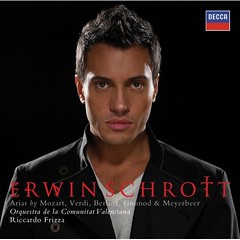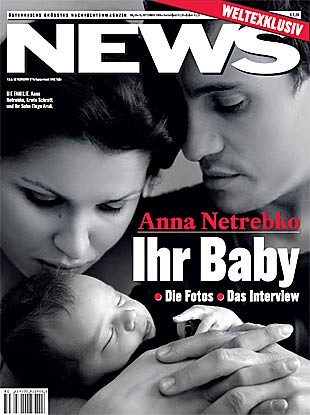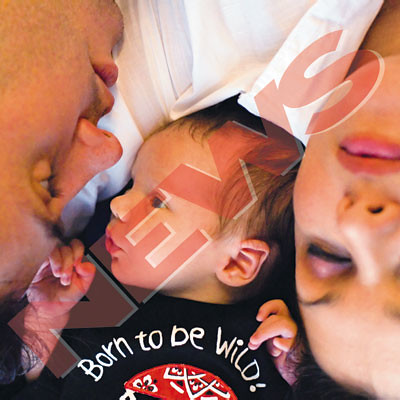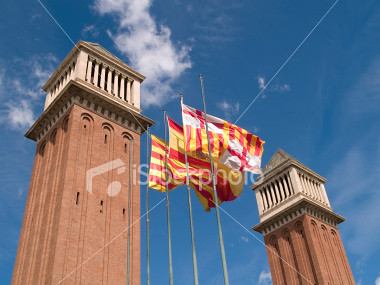
Ópera, ópera, ópera, ópera, cinema, música, delírios psicanalíticos, crítica, literatura, revistas de imprensa, Paris, New-York, Florença, sapatos, GIORGIO ARMANI, possidonices...
domingo, 28 de setembro de 2008
O Exame Prévio...

Uma varejeira que por aí esvoaçava, pestilenta e desagradável, pretendia ganhar posição neste espaço. Teve o que merecia, a pobre: o extermínio!
Doravante, antes de o fiel e civilizado leitor ver publicado o seu comentário aos posts, apenas terá de aguardar... pelo exame prévio! As minhas desculpas, à gente de bem ;-)))
sábado, 27 de setembro de 2008
Met 2008 / 2009 - The Opening Night
Fleming é esbelta e elegante, tem um timbre de ouro, aveludado e fino. Indubitavelmente, é a mais bela voz do universo lírico da sua geração. Pessoalmente, considero que veio ocupar o lugar (precocemente abandonado) de Cheryl Studer, também ela americana, por coincidência!
Renée Fleming é uma extraordinária cantora, uma actriz mediana e uma intérprete de referência. O povo que aprecia a lírica – onde me encontro, naturalmente – adora-a. Tolera-lhe os maneirismos e vícios de vedeta, que nada têm de transcendente. Fleming é uma criatura quase divina, afinal! A intelectualidade bafienta e possidónia acha-a "pindérica". Como não é chata, nem aborrecida, não capta as atenções desta última categoria de apreciadores (?) de música.
Vem esta prosa, caro e fiel leitor, a propósito da abertura da temporada 2008 / 2009 do Met, integralmente a cargo da grande, grande Renée Fleming.
Fleming interpretou três dos seus predilectos papeis: Manon, Violetta e a Condessa (Capriccio).
Fora eu a escolher o repertório e outro galo cantaria: Fiordiligi, a Condessa (As Bodas de Fígaro), Marchalina, Tatiana, eventualmente Manon, Desdemona...
Renée Fleming é, por natureza, um soprano lírico, tendo sido talhada para Strauss e Mozart! Eis o meu veredicto!
Pois bem, na dita Opening Night – que adulou o seu narcisismo, seguramente -, todos se vergaram diante do seu talento, incluive alguns dos mais destacados costureiros do momento, Lacroix, Galliano e o insuportável Lagerfeld.
«The Metropolitan Opera opened its 125th-anniversary season on Monday evening with a gala Renée Fleming showcase. Everything about the three-part evening was fashioned, quite literally, for Ms. Fleming.
She was featured in three favorite roles: Violetta in Act II of Verdi’s “Traviata”; Manon in Act III of Massenet’s “Manon”; and the Countess in the final scene of Strauss’s “Capriccio,” conducted by Patrick Summers. To lend an extra touch of diva dazzle to the evening, the Met commissioned three renowned fashion designers to create Ms. Fleming’s costumes: Christian Lacroix for “Traviata,” Karl Lagerfeld for “Manon” and John Galliano for “Capriccio.”
For weeks waggish opera bloggers had been calling the evening “The Renée Fleming Fashion Show,” “The Renéesance” and such.
(...)
Ms. Fleming had clearly wanted her special night and hoped to make it enjoyably luxurious. Still, she had serious artistic goals. Hearing her in three works of such contrasting styles did not make for the most cogent operatic experience. But it was a challenging feat to bring off. She gave her all and, for the most part, sang beautifully.


(Fleming como Violetta, La Traviata, de Verdi)
In Act II of “La Traviata,” when we find Violetta living in an airy country home near Paris with her smitten lover, Alfredo, Ms. Fleming, from her first phrases, sang with supple phrasing and found a distinctive vocal coloring — earthy, tremulous, clarion — to match the dramatic and musical moment. As is her way, she took a boldly expressive approach to dynamics, which is not to all tastes. Still, I have seldom heard the music sung with such rhythmic honesty.
(...)
Marco Armiliato conducted Act III of “Manon,” in the highly stylized, handsome production by Jean-Pierre Ponnelle. The act begins at an outdoor fair in Paris, a scene crowded with festive people: vendors, acrobats and more. As the coquettish and fatally superficial young Manon, Ms. Fleming played things to the hilt, tossing off the florid and coyly alluring melodies, soaking up the adulation of the crowd. But she was at her best in the second scene. Learning that the disconsolate lover she abandoned, the Chevalier des Grieux, is about to take vows as a priest, she tracks him down at the Chapel St. Sulpice and lures him back during an intense and unrelenting duet. Mr. Vargas, as des Grieux, was again in ardent form.
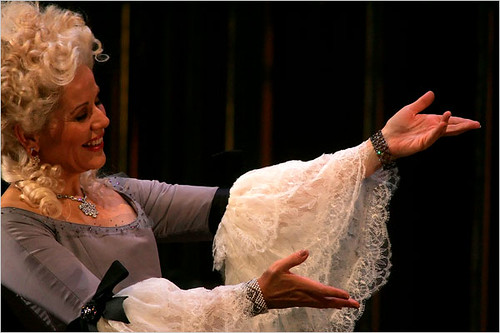
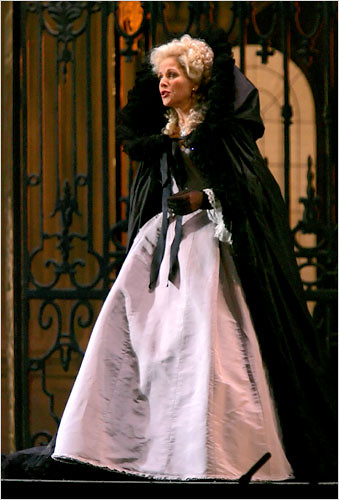
(Renée Flemng na pele de Manon, da ópera homónima de Massenet)
But the highlight of the program was the final 20-minute scene, nearly a soliloquy, from Strauss’s final opera, “Capriccio.” This opera is a breezy yet profound dialectical drama that explores an aesthetic question: Is the music more important than the words in song?
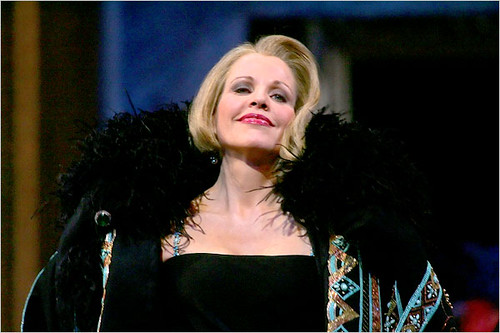
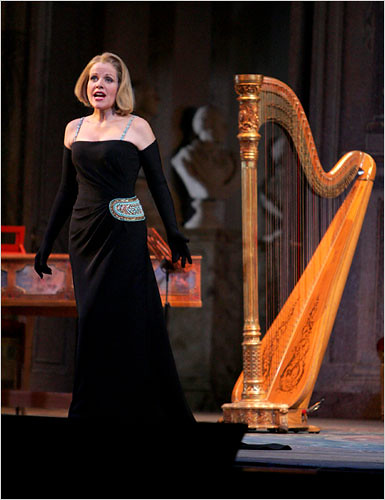
(Fleming como Condessa, em Capriccio, de Richard Strauss)
(...)
As the Countess facing the question, Ms. Fleming lovingly shaped the arching, infectious phrases and showed this keenly perceptive character going through bouts of confusion, girlish ardor, flattered vanity and world-weary resignation.»
domingo, 21 de setembro de 2008
Paradoxal

(DECCA 478 0473)
Mozart constitui, ao que parece, a espinha dorsal da carreira de Schrott. São já celebres os seus Figaro (o de Covent Garden, particularmente) e Leporello (nomeadamente o de Salzburgo, edição de 2008).
Pessoalmente, as leituras mozartianas de Erwin Schrott constituíam a raison d’être deste registo... Enganei-me redondamente!
O Mozart do intérprete uruguaio, apesar de oleado e amadurecido pelos palcos, enferma de grande banalidade: neutro, sem ponta de graça, nulo em ironia e parco em malícia.
Em Verdi... o caso muda de figura!
Schrott, com escassos trinta e cinco primavera, ousa o que muitos apenas se atreveram após a meia-idade, ossia abordar os "pesos-pesados" verdianos - Philippe (Don Carlos), Banco (Macbeth) e Procida (Les Vêpres sicilienne).
Em duas palavras, Erwin Schrott oferece-nos um Verdi deslumbrante, teatralmente investido – quanta dilaceração no Elle ne m’aime pas -, gozando de uma maturidade plena. O intérprete - ainda em Verdi – destaca-se pela robustez vocal e estilo admiráveis: a voz ampla e musculada, de timbre másculo, apresenta um colorido magnífico (ou muito me engano ou Schrrot inspirou-se no Verdi de Ghiaurov...)
À côté, este registo conta ainda com algumas incursões endiabradas – os Mefistófeles de A Danação de Fausto e Fausto -, irresistíveis, de um sarcasmo absoluto, apoiadas num francês impecável, de dicção bem aberta.
Sinteticamente, diria que, em Mozart, Schrott pouco mais além vai da banalidade, ao passo que em Verdi, seguramente inspirado e espiritualmente apadrinhado pelos baixos eslavos (Christoff e Ghiaurov), o mesmo Schrott transcende-se, candidatando-se a referência!
Veremos, veremos, com prudência...
___________
* * * * * (4/5)
sábado, 20 de setembro de 2008
Momento KITSCH...
As heroínas de Isokoski
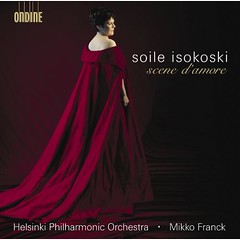
«"Patrician" and "aristocratic" are epithets that critics habitually reach for when describing Finnish soprano Soile Isokoski, a favourite at the Vienna Staatsoper but heard all too rarely in Britain. In her early fifties, Isokoski still preserves the pure, rounded tone, dead-centre intonation and shining top notes that have always been her hallmarks. She is a scrupulous stylist, never forcing her voice, and spinning seamless lines on apparently inexhaustible reserves of breath. Voice-fanciers have long been lamenting that true legato is a dying art. With Isokoski around, it is not dead yet.
For those who have accused Isokoski's singing of being too coolly "instrumental", this recital, encompassing seven of her stage roles, may come as a surprise. Granted, she rather misses Marguerite's breathless delight in the Jewel Song from Gounod's Faust, though there is compensation in the diamantine precision of her scales and perfectly placed high notes.
Inevitably, too, her Tatiana is not quite the fragile ingénue conceived by Tchaikovsky and Pushkin. But her beauty of line and tone - now with a dark, Slavonic glint - and her emotional commitment make the Letter Scene intensely moving.
Elsewhere Isokoski is impassioned and anguished in Micaëla's "rescue" aria from Carmen, while really caring for the curve of the glorious melody. She lightens her tone in a delightful, subtly coloured account of Mimì's aria from La bohème, soaring thrillingly at the climax, and is true and touching in Liù's farewell, with no hint of mawkishness.
Amelia's bittersweet aria from Simon Boccanegra is a model of delicate expression and fine-spun Verdian cantabile, slightly compromised by the orchestra's over-emphatic evocation of the shimmering Mediterranean night. But in the main, Franck accompanies sensitively, nowhere more so than in Desdemona's "Willow Song" and "Ave Maria", where Isokoski's poignant simplicity is shot through with foreboding, even terror.»
Há muitos anos que sigo a notável carreira de Soile Isokoski, a elegantíssima.
Não me canso de recordar As Quatro Últimas Canções, de Richard Strauss, que interpretou em Paris, em 2000, no Théâtre des Champs-Élysées. Que recato, que nobreza, que suavidade e que – faltava a incontornável – elegância!
Em Lisboa, há cerca de dois anos, brindou-nos com uma inesquecível cena final de Capriccio e duas leituras sublimes de árias de Ariadne auf Naxos.
Isokoski nunca conseguiu – ou não quis! – gravar para as majors, com poucas excepções. Tanto melhor! A (igualmente finlandesa) ONDINE é a sua casa discográfica.
Pelas bandas lusas, a ONDINE encontra-se pessimamente representada e distribuída! Em abono da verdade, diga-se que os registos de Isokoski que fui coleccionando foram adquiridos pelo mundo fora.
Na eventualidade de o leitor não encontrar o cd acima identificado, a Itunes já o disponibilizou. Para grandes males, grandes remédios!
Pela minha parte, a escassos dias de partida para a capital da Catalunha, vou juntando cobres para mais uma aquisição discográfica.
B & B
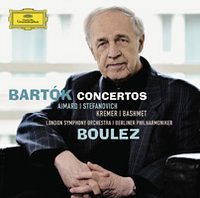
Bartók e Boulez têm um percurso e obra conjunta.
Em final de carreira, Boulez encerra o seu ciclo Bartók, que foi figurando na minha cdteca, desde o início.
Eis o epílogo de B & B.
quinta-feira, 18 de setembro de 2008
Beleza, beleza vocal...
Se, além de inegáveis dotes vocais e interpretativos, a criatura for esbelta, tanto melhor, caramba! Todos ficamos a ganhar, excepto os invejosos!

(Mattila ossia Salome absoluta, bela por fora...)
Tiradas deste calibre são, pois, dispensáveis:
«(...) one thing opera buffs have always valued about their beloved art form is that so many excellent opera singers look like everyday people, like us. There is no reason that Rodolfo and Mimi have to look like supermodels. They need only convey that they are beautiful to each other. The music, if sung with tenderness and passion, does the rest.»
Diga-me o fiel leitor o que prefere: uma Salomé esbelta e atraente – além de boa cantora - ou um "camafeu", dotado de invulgar beleza... vocal? Já agora, será melhor um Don Giovanni ao estilo de R. Raimondi ou G.London (ambos feios até aos pés) ou um artista de tipo atlético, ao estilo de S. Keenlyside ou E. Schrott???
quarta-feira, 17 de setembro de 2008
Lincoln Center for the Performing Arts: 50º aniversário

Os melómanos - como eu, once again - consideram o LCPA um dos mais magníficos espaços de fruição cultural.
Comme par hasard, o Met - a catedral do LCPA - situa-se na zona mais nobre do dito centro, sendo a sua alma.
Pois bem, à beira de comemorar 50 anos de vida, as festividades estão aí, para quem quiser!
«On May 14, 1959, President Dwight D. Eisenhower thrust a shovel into the ground on the Upper West Side of Manhattan to signal the start of construction on Lincoln Center for the Performing Arts. With the maestro Leonard Bernstein as the master of ceremonies, the New York Philharmonic and Juilliard Chorus performed the national anthem. The Metropolitan Opera baritone Leonard Warren sang the prologue to Leoncavallo’s “Pagliacci.” The mezzo-soprano Risë Stevens sang the “Habanera” from Bizet’s “Carmen.”
On Wednesday Lincoln Center will announce a yearlong series of events to celebrate its half-century of existence. The 50th anniversary will be celebrated amid a construction site: Lincoln Center is in the middle of an ambitious $1.2 billion redevelopment plan that is not to be completed until 2011. But parts of the project will be finished, including a refurbished Alice Tully Hall, a renovated Juilliard School and most of the fountain plaza.
In May 2009 the Paley Center for Media will show a selection of Lincoln Center television shows that were never commercially released, including the 1962 opening-night telecast from Philharmonic Hall (later renamed Avery Fisher Hall); the 1966 Bell Telephone Hour special “The New Met: Countdown to Curtain”; and the 1969 gala concert “Juilliard Comes to Lincoln Center.”»
Terfel popular, MA NON TROPO!!!

(If Ever I Would Leave You)

(Something Wonderful)
Dois registos, do século passado - é certo... -, ilustrativos do génio posto ao serviço do popular, de bom gosto, ossia anti - kitsch!
Deleitai-vos!
terça-feira, 16 de setembro de 2008
Cassandra Wilson - Loverly

Nada lânguida, pouco dada a grandes rupturas, a tonalidade afro é indiscutível.
Para degustar, em clima de descontracção recatada.
segunda-feira, 15 de setembro de 2008
Terfel: First Love...

Embora com dissabor, reconheço que as minhas expectativas não foram defraudadas... É verdade que ainda não tomei contacto com o produto, mas...
«In which opera star Terfel fashions a Celtic kitsch crossover album. The Ronan Keating-guesting 'Danny Boy' is a weak spot, but 'Scarborough Fair' - which features another guest, soprano Kate Royal - is rather gorgeous. And while the Pogues and Dubliners' take on 'Molly Malone' is more enjoyable than Terfel's, this is a fantasy of Celtic lore that your auntie might adore.»
So, so, como diria o meu amigo Raul, não Caríssimo?
sábado, 13 de setembro de 2008
Woody Allen encena Gianni Schicchi, de Puccini, em LA
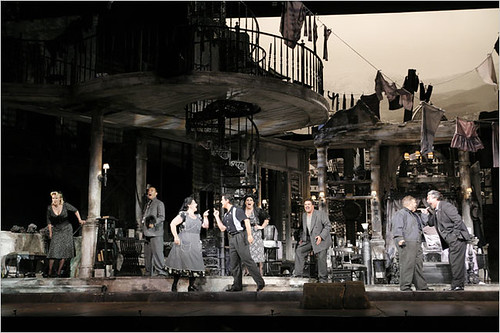
(Gianni Schicchi, Ópera de Los Angeles Opera, encenação de Woody Allen)
Woody Allen – a quem nunca achei particular graça, nem como realizador, nem como actor -, ao cabo de muita insistência, acedeu, por fim, a encenar uma ópera. Domingo havia-lhe lançado o desafio há, pelo menos, década e meia!
Allen assinou, pois, a mise-en-scène de Gianni Schicchi, de Puccini, que a Ópera de Los Angeles tem em cartaz, presentemente.
O leitor atento sabe, com certeza, que Puccini não conta entre os maiores, para este blogger…
Dito isto, Allen... e Puccini..., apesar de tudo, pela calorosa recepção, merecem uma referência neste espaço!
A avaliar pela reacções – The New York Times e Le Monde -, a coisa correu pelo melhor ao ora metteur-en-scène!
«Pour ce final, Woody Allen a surpris en transposant l'oeuvre de Puccini de la Florence médiévale à une Italie contemporaine, et en animant tous les personnages de cette farce, qui se disputent un héritage. Il injecte d'emblée son humour et ses calembours dans un générique sur écran blanc qui annonce : "Prosciutto e Melone Productions..." (une production jambon et melon).
(…)
En quoi consiste le défi de l'opéra pour un novice ? "Empêcher une quinzaine de personnes de se cogner les unes contre les autres dans un espace restreint !", répond-il.
Sa décision de transgresser les règles de l'opéra en faisant jouer tous les personnages, tout le temps, même quand ils ne chantent pas ? "Je ne peux pas imaginer de les laisser sur la scène, debout là, à ne rien faire ! Pour moi, c'est plus naturel de procéder ainsi, c'est ce dont j'ai l'habitude." Il confirme qu'on lui a proposé beaucoup d'opéras et même de filmer La Bohême, de Puccini (le projet n'a pas abouti), mais il ne prévoit pas de réorienter sa carrière : "Je ne me vois pas monter un opéra de trois heures !"»
«Far from being incompetent, his “Gianni Schicchi” is a cleverly updated and inventive staging of the popular comedy, marred only by a regrettable directorial liberty at the end. In another recent comment to the press, he described “Gianni Schicchi” as “funny compared to ‘Tosca,’ not funny compared to ‘Duck Soup.’ ” True enough, though as the performance began I was briefly worried that Mr. Allen was determined to turn Puccini into the Marx Brothers.
Though the libretto places the story in Florence in 1299, this “Gianni Schicchi” begins with a comic montage of film credits — all mock-Italian names like Giuseppe Prosciutto and Oriana Fellato. A street band plays “Funiculì, Funiculà” in the background. Though silly, the gimmick sets the tone for what comes when Puccini’s music begins and the curtain goes up. With sets and costumes by Mr. Allen’s longtime collaborator, Santo Loquasto, the production has the look and style of some old black-and-white film. Not one of those black-and-white Woody Allen films. Think “Big Deal on Madonna Street.”
In a two-story house in Florence, members of a large, boisterous family are bustling around the deathbed of their wealthy relative Buoso Donati. There is pasta boiling in pots on the stove, laundry hanging on crisscrossing clotheslines above and a young boy practicing knife thrusts with a vengeance.
Buoso Donati’s relatives fear that he has left his money, country properties and ample city house to a monastery, a fear borne out when they locate his will. So young Rinuccio suggests that they turn for help to a newcomer, the clever Gianni Schicchi, who is still not trusted.
With comic pacing and dialogue already determined by Puccini, Mr. Allen may have felt there was not enough for him to do. So he fills the show with sight gags and busyness, perhaps too much so. Still, the comic maneuvers of the cast are deftly choreographed, and he elicits feisty portrayals from the singers.»
Terfel ossia Wotam
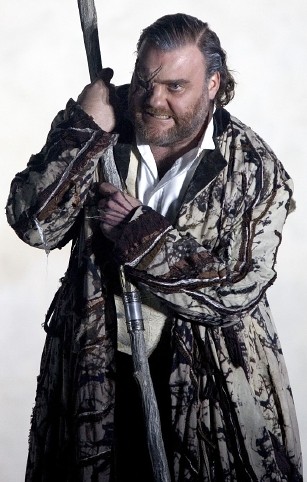
“Next year he embarks on a Ring at the Met in New York directed over three years by Robert Lepage. "I can't wait for that." And then there's Der Meistersinger von Nürnberg in Cardiff.”
Terfel regressa a Wagner...
O papel de Wotam, na actualidade, conta com dois – pouco mais, em boa verdade – intérpretes de referência: Terfel e Pape.
Enquanto Pape ensaia a incarnação total – que terá lugar em Bayreuth, dentro de dois ou três anos -, Terfel reconcilia-se com o pai dos deuses wagnerianos, depois do famigerado episódio de há duas temporadas em que, em cima do acontecimento, no Covent Garden, anulou a sua prestação.
O público – e a imprensa -, pouco dado à compreensão da lógica fóbica – que determina inibições, por vezes incontornáveis -, crucificou-o. Com a Callas, em 1958, por exemplo, fizera o mesmo...
Por mim, regozijo! Previra uma saltada à Big Apple, justamente no ano que vem, a pretexto da Tosca, com Mattila e TERFEL! Portanto, o Wotam de Terfel será mais um argumento de peso em favor da deslocação a NYC!
sexta-feira, 12 de setembro de 2008
quarta-feira, 10 de setembro de 2008
Who's that Girl?

segunda-feira, 8 de setembro de 2008
Tiago (Arua Schrott)
Anna Netrebko e Erwin Schrott foram pais de um rapaz, Tiago de sua graça, nascido em Viena, a 5 de Setembro.
Segundo consta, a origem do nome do primogénito é portuguesa, evidentemente! Escusado será dizer quem sugeriu tal graça!
Moral da história: todos temos o nosso Tiago!
Eis o meu, que é o mais belo e grandioso do mundo:

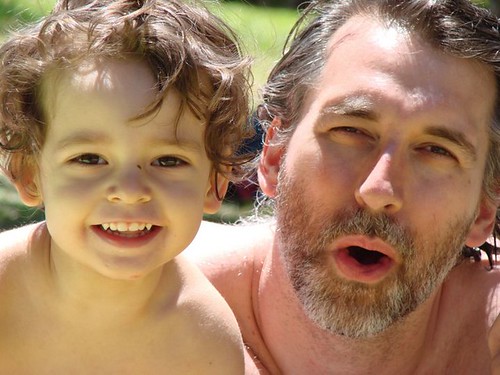
Manifesto vs Latente: Giorgio Germont & Violetta Valery
A relação que une Alfredo, Giorgio e Violetta é, em sentido literal e figurado, triangular, sendo que a rivalidade pai-filho - movida pelo desejo comum pela mesma mulher - surge camuflada.
Parece-me óbvio que Violetta suscita desejo em Giorgio que, a pretexto do seu bom nome e das convenções, implora que a cortesã rompa o vínculo que mantinha com o filho. Doravante, creio haver um lado do pai que regozija com o espectro – imaginário e hipotético, claro está – de uma união com a desejável Violetta...
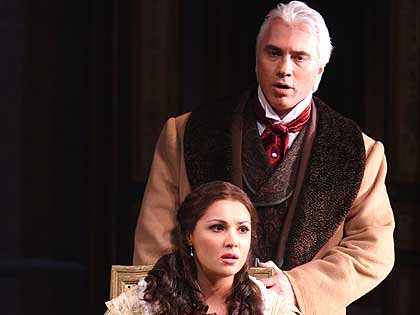
(Violetta Netrebko e Giorgio Hvorostovsky)
Verá o leitor que, previsivelmente, não me fiquei por considerações psicanalíticas sobre Tosca. Outras – muitas, muitas – haverá mais, além da presente!
domingo, 7 de setembro de 2008
Les DEUX ENFANTS du Régiment & Kleenex
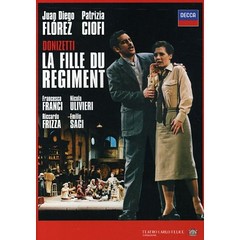

Esta excelsa produção, montada em Génova, data de 2005, ano da graça de Flórez.
Cuidada e singela – despretensiosa, mas nada superficial -, a encenação transporta-nos para os anos 1940, decorrendo a trama em plena II Guerra Mundial.
Juan Diego Flórez compõe o melhor Tonio de sempre, ofuscando os dois grandes que o antecederam – Kraus, excessivamente sério, e Pavarotti, superficial em demasia. Nem o francês de pacotilha abala o seu trabalho!
O Tonio de Juan Diego transpira ingenuidade e emoção. O timbre é brilhante e luminoso, quente e pleno de afecto. Em nada se poupa, bisando sem hesitações Ah mes amis - daí em diante, foi o que se sabe: a proeza repetiu-se no Scala, Met e por aí fora (Lisboa inclusive!).
Os grandes homens são assim, nem à comoção se escapam. E nós, menos ainda... (os kleenex foram encetados nesta altura).

É bem verdade que a personagem de Flórez não convoca grande investimento dramático, mas o mais pequeno deslize, não raras vezes, redunda numa figura apatetada e tonta. O tenor peruano, por via desta magistral Tonio, mostra-nos que a figura interpretada não se limita à ligeireza e agilidade costumeiras. O seu Tonio é generoso, terno, apaixonado e heróico!!!
Ciofi, por seu lado, desenha uma Marie de mão cheia. Não tendo, nem o cristal, nem o veludo de uma Dessay – o timbre é, de facto, banalíssimo e há acidez em excesso nos agudos -, a soprano afirma-se cenicamente. E que importa quando uma incarnação é tão plena e rica?!
Vocalmente, há Maries’s que a ofuscam – Sutherland, Anderson, Dessay e até Sills - mas, no teatro, Patrícia Ciofi é inigualável! O histrionismo e labilidade da intérprete são notáveis: passa do riso às lágrimas com uma tal agilidade!
Obrigatórios são - antes de mais - a cena da lição de canto (início do acto II), absolutamente arrebatadora, pela graça desconcertante, e, num plano mais intimista, lírico e disfórico, C’en est donc fait, et mon sort va changer. No final deste último trecho, uma vez mais, o público enlouquece, Ciofi comove-se e eu também – sai outro kleenex...

Palmas ainda – muitas, muitas – para a hilariante Marquise de Francesca Franci, o sedutor Sulpice de Nicola Ulivieri e a generosa, enérgica e feérica direcção de Frizza.
___________
* * * * *
sábado, 6 de setembro de 2008
Le FILS du Régiment

Não estando isento de fragilidades, aconselho-o vivamente.
A fundamentação virá depois, quando me apetecer!
Em todo o caso, neste registo, a filha cede a glória ao FILHO, verdadeiro herói lírico!
Fleming & Strauss: (re) Vier Letzte Lieder

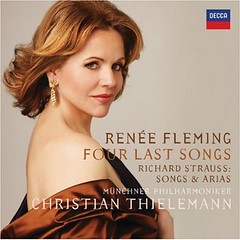
Para que conste, a anunciada interpretação de As Quatro Últimas Canções, de Richard Strauss, por Renée Fleming, corresponde a uma revisitação deste repertório por parte da soprano norte-americana.
Pouco tendo que ver com Schwarzkopf, Fleming reaborda o ciclo, em estúdio, desta feita em plena maturidade - à semelhança da dita Senhora Alemã, que visitou a obra no início e final da carreira.
Tanto quanto sei, Schwarzkopf e Fleming foram as únicas intérpretes a cometer semelhante proeza, até à data.
Esta magistral obra, a meu ver, nunca deve ser ousada antes do primeiro vislumbre do final da vida – que imagino ocorrer pelos cinco decénios de vida...
A primeira leitura de Schwarzkopf enferma de uma evidente falta de melancolia. Já a segunda – que não tem paralelo em toda a discografia – transpira serenidade, poesia e uma tristeza de interminável beleza.
Honestamente, espero que a reprise de Fleming siga o trilho da de Elisabeth Schwarzkopf, posto que a primeira incursão daquela - que adquiri em Paris, depois de um dia de trabalho para esquecer -, pouco mais me despertou além de aborrecimento: o vibrato em excesso e uma desabitação teatral gritante, em territórios desta envergadura lírica, não se toleram!
Ver-se-á, em breve...
sexta-feira, 5 de setembro de 2008
La Sonnambula - Bartoli & Ca
Seguramente a não perder!
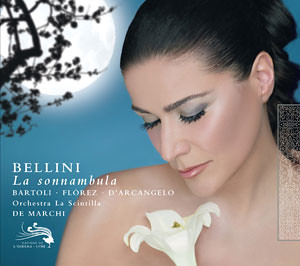
quinta-feira, 4 de setembro de 2008
Rentrée discográfica lírica
Evidentemente, nem todas me seduzem. Em todo o caso, voici as mais aparatosas:
Novidades:
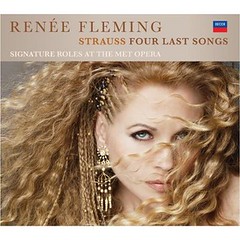

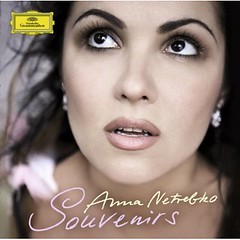
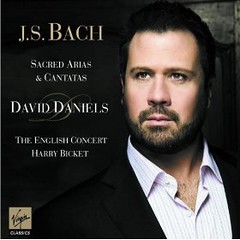
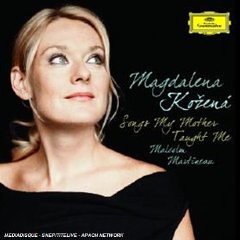
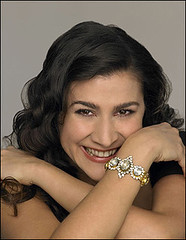 *
*Reedições:


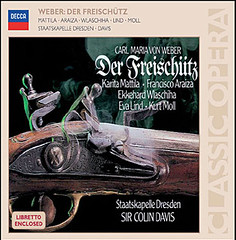
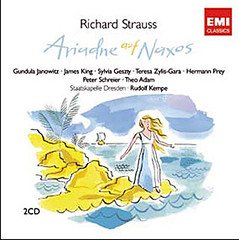
DVD:
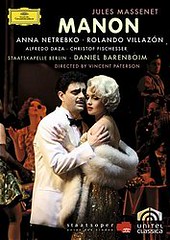

quarta-feira, 3 de setembro de 2008
Bayreuth: from now on...
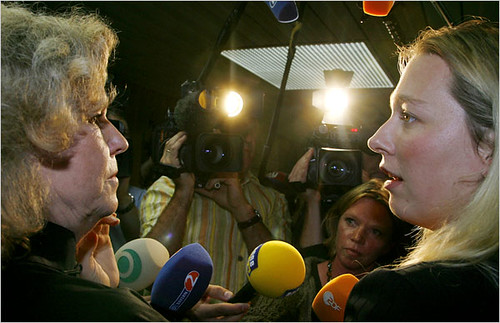
Em Bayreuth, os dados estão lançados!
A coexistência Katharina - Eva Wagner à frente dos destinos de Bayreuth – e o consequente afastamento da dupla Nike Wagner - Gerard Mortier da putativa direcção do mítico festival – seria da ordem do fait divers, não fora a circunstância de envolver, justamente, a preservação da inigualável obra de Mestre Richard.
«Las dos hijas de Wolfgang Wagner, Katharina y Eva Wagner-Pasquier, sucederá a su padre al frente del Festival Richard Wagner de Bayreuth, la cita operística que el patriarca y nieto del compositor ha dirigido durante más de medio siglo. El Consejo de la Fundación del festival tomó esta decisión este lunes, destinada a zanjar el largo litigio pro la dirección de Bayreuth entre estas descendientes de Wagner y otra biznieta del compositor, Nike Wagner.
Las hermanastras Katharina y Eva, hijas del segundo y primer matrimonio de Wolfgang, respectivamente, habían acordado esta solución de compromiso a modo de dirección bicéfala.»
Evidentemente, não acredito em direcções bicéfalas!
Basta conhecer Der Ring – o incontornável manual de ciência política, que os ilustres políticos ignoram, maioritariamente - para perceber que, tanto nos Wagner como ailleurs, o poder não resiste a compromissos.
O que esta pseudo-aliança pretende é, em minha opinião, propor uma solução neurótica – psicanaliticamente falando, ossia estabelecer um compromisso entre opostos.
Como se sabe, em Der Ring, o poder enlouquece, escraviza e destrói, sendo que nada resiste à sua força.
Ou muito me engano ou esta direcção dificilmente escapará à compulsão à repetição...
«The composer Richard Wagner and his wife Cosima launched the festival in 1876 and resided in their famous “Wahnfried” villa in the city which like the festival, rapidly became a magnet for opera lovers from throughout Germany and abroad.
Hitler became a fanatical Wagner fan in the early 1900s. He regarded the reputedly anti-Semitic composer as a genius who had managed to capture the nation's Germanic soul in his music. Biographers say that he likened listening Wagner's work to a mystical or religious experience.
By the 1930s, the Nazi leader was a regular visitor to Bayreuth. He became a close friend of the British-born Winifred Wagner (nee Williams), the wife of Richard Wagner's son Siegfried. Winifred, who is reputed to have shared Hitler's anti-Semitism, referred to the Nazi leader by the nickname “Wolf”. There were even rumours that the two would marry.
Hitler responded by turning Bayreuth into a cultural Mecca for the Nazis. The festival was given special status and funding. Winifred referred to Hitler as “our blessed Adolf” and kept a framed photograph of the Nazi leader on her desk right up until her death long after the war. She never questioned her support for Hitler with whom she corresponded frequently. The Wagner family has refused to release them, preferring to keep the locked in a bank vault.
The music of Richard Wagner has since never managed to shed its associations with the Nazi era. The foundation that runs it has always stipulated that a Wagner family member should run the event. But Bayreuth is nowadays one of Germany's key cultural occasions. Its programme runs for only a month each summer but attracts the nation's artists and the political and business elite.
Chancellor Angela Merkel who is an ardent Wagner fan and frequent visitor, chose the event to appear for the first time in public with, her normally reclusive husband Professor Joachim Sauer.
Winifred's sons Wolfgang and Wieland were handed the reins of the festival when it reopened after World War II. Wieland was considered the true heir to Richard Wagner and regarded as a genuine creative genius. Yet he died in 1966 and sole control was then given to the less gifted Wolfgang.
Almost from then on, the Wagner family's feuding became almost as well known in Germany as the composer and his festival. Wolfgang's son, Gottfried Wagner would have been his father's natural successor at Bayreuth. However Gottfried disgraced himself early on the “Green Hill” by publishing details of Richard Wagner's anti-Semitism and of Winifred's fanatical admiration for the Nazis.
Yet the family feuding had hardly started. Nike Wagner, the daughter of Wolfgang's talented brother Wieland, followed up with a blistering attack on Wolfgang in which she described him in true Wagnerian-style as “the shadow attached to Wieland's heels, the demon who sucked the blood from his veins in the full light of day, the sprite he had crushed a hundred times but who always returned to his feet.”
The battle for control of Bayreuth began in earnest in 2001, after Wolfgang flatly refused to accept the board's suggestion that his daughter Eva should step in to replace him. Nike waded in with an initial counter bid. However Wolfgang rejected them both.
In the interim he had remarried his secretary and press officer, Gudrun Wagner and she had given birth to Katharina, their daughter. Until late last year, Wolfgang had doggedly refused to accept the board's recommendations, first attempting to install Gudrun as his successor and latterly, the tall, blonde, Teutonic-looking Katharina.
Nike's acid response was that Gudrun, who had by then become the eminence grise of Bayreuth, had reached her position “not through art and culture but via the nuptial bed”. Then last year and wholly unexpectedly, Gudrun died.
Katharina was given her debut at the festival and promptly turned out a somewhat controversial version of Wagner's celebrated “Meistersinger von Nuremberg” which featured singers equipped with strap-on penises. Earlier this year Wolfgang finally accepted a board recommendation that Eva and Katharina should take joint control of the festival.
Katharina told Germany's mass circulation Bild newspaper last week that she wanted to show that Wagner was “all about stories with dragons, heroes and magic powers.” She added: “I want to start a massive debate about Bayreuth's past. Why did Hitler love Wagner and how come the Nazis had such an influence?” she asked.
Despite yesterday's official end to hostilities, there is plenty left within the clan Wagner for further controversy - if not another feud.»
O leitor verá que, tal como noticia o The New York Times, a querela envolve questões que transcendem a mera arte...
«With the German news media following the selection with “American Idol”-style breathlessness, the foundation board met on Monday and heard from both sides. It is dominated by officials of the federal, state and local governments, but also has four Wagner family members. The foundation voted in favor of the Wagner half-sisters 22 to 0, with two abstentions, said the German culture minister, Bernd Neumann.
Mr. Neumann welcomed the choice, and more important, he said the federal government would continue “to be committed to its responsibility to support the Bayreuth Festival.” The federal government provides 10 percent of the festival’s annual $23.3 million budget, with another 20 percent coming from state and local governments.
The new team’s plans should be adopted, the minister said, “so that the most famous opera festival in the world continues to do justice to its exemplary role as the trailblazer and hub for the artistic examination of Richard Wagner’s works, his tradition and his international reputation.”»
Aqui para nós, a encenação iconoclasta – e desprezível... – que a (so far...) incompetente Katharina propôs, na edição passada do festival, de Os Mestres Cantores de Nuremberga, contem algo de premonitório! Oxalá eu me engane!
terça-feira, 2 de setembro de 2008
I Bassi
Por estas bandas, já figuram os registos há muito esperados de Pape e Schrott. Quanto ao de Terfel - o mais que tudo dos baixo-barítonos e quejandos -, prudência, prudência... O material preview inspira-me grandes hesitações...
Ver-se-á!

